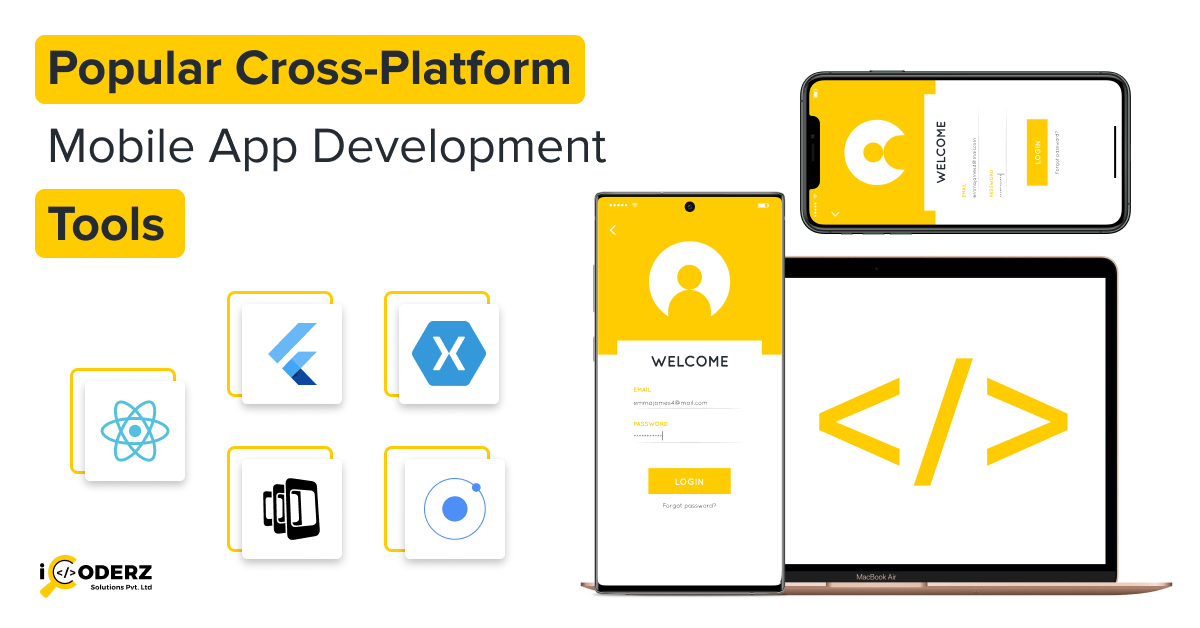Table of Contents
Mobile apps development is a complex and time-intensive process. Developing an effective application that can run on multiple platforms simultaneously is challenging for developers. Cross-platform app development helps businesses reach their target audience better.
Cross-Platform Mobile Apps Development is a mobile app executable framework on multiple platforms such as Android, iOS, and Windows. Developers only need to write code once, and it can be implemented anywhere on any platform. Some other benefits of using the cross-platform framework for mobile apps development are:
- The code is reusable
- Cloud Integration
- Cost-effective
- Easy Hosting
- Low technical barriers
Some of the major Cross-Platform Mobile Apps Development Tools are:
1) React-Native App Development:
- React Native app development is a framework created by Facebook that enables smooth and easy cross-platform mobile development. This means that you do not need to create an iOS and Android app separately. You need codebase to develop beautiful applications for both platforms, without compromising the UX and UI experience.
- The mobile app development process on this platform is really fast and businesses can launch their app on both platforms without compromising on quality. The framework is compatible with 3rd party plugins and uses very little space in memory.
- Some well-established brands are already using this framework for their mobile apps development; these include Walmart, Uber Eats, and Skype. This is a preferred option for start-ups or small-sized businesses because it works under strict budget constraints.
- The rich look and feel of react-native app development ultimately depend on the capabilities of the developers. You need the right partner to work with and that part will never change.
Some of the major benefits of react-native app development are:
- Your app will deliver faster than the original one.
- The development team consists of only 5 people instead of 8 or more.
- Tester to spend less time on regression tests.
- The bugs can be fixed quickly.
2) Flutter app development:
- Flutter app development is Google’s new open-source technology for building native Android and iOS apps with a single codebase. Unlike other popular solutions, Flutter is not a framework; this is a complete SDK – Software Development Kit – which already requires you to build a cross-platform application. It includes a rendering engine, ready-made widgets, testing and integration APIs, and command-line tools.
- Flutter app development follows the reactive development architecture, but with a twist. The main thing to know about reactive programming is that it automatically updates the UI content when you update variables in the code. Since the app has to cross this bridge every time to access widgets, this can cause performance problems. However, the flutter leaves the bridge altogether and communicates with the local platform using Dart.
Some of the advantages of flutter app development are:
- Built-in and custom widgets for fast UI coding.
- The Flutter team found that mobile development experience was not necessary to get started with Flutter.
- Dart is a modern object-oriented language that reminds you of Java or C ++ with its syntax. It supports strong and weak typing styles, making it easy for beginners to choose.
- Hot reload function for instant updates. Reloading allows you to see updates in real-time.
- The Flutter team promises a steady 60 fps, at this rate modern screens display a smooth, clear picture.
3) Xamarin
Applications developed using this framework are built using the C # – shared codebase. This framework is a bit expensive for companies because they need to buy a license for Microsoft’s Visual Studio. The tool was launched by Microsoft, so it’s easy to use this framework for mobile app development if the developer is familiar with the Microsoft app.
4) Phonegap
Phonegap was launched by Adobe, a cross-platform mobile apps development tool for creating open web technology-driven mobile applications. It uses languages like HTML5, CSS, and JavaScript for application development. The framework provides access to third-party tools and many plugins.
5) Ionic
Ionic Hybrid is an open-source cross-platform mobile apps development framework for mobile apps development. Framework Allows users to select any user interface framework, such as React and Angular. Some of the companies that have used this framework to create applications are IBM, SAP, and NASA.
Continue Reading…
Cross-platform networks are used by many well-established businesses such as SAP, IBM, Google Advertising, NASA, and Alibaba. Using this framework, businesses can target more audiences and save money compared to other platforms.
With so many options available on the market, it is not always easy to choose the best development tool. So take a look at my list of top cross-platform app development tools, or you can consult professional mobile app developers to build your mobile app.
Conclusion:
iCoderz Solutions help with creative and innovative mobile apps developing using cross-platform technology. Clients can request the quote for cross-platform mobile app development by logging on to the official website.





1 comment